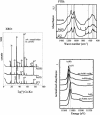Immobilization of arsenite and ferric iron by Acidithiobacillus ferrooxidans and its relevance to acid mine drainage
- PMID: 14532077
- PMCID: PMC201175
- DOI: 10.1128/AEM.69.10.6165-6173.2003
Immobilization of arsenite and ferric iron by Acidithiobacillus ferrooxidans and its relevance to acid mine drainage
Abstract
Weathering of the As-rich pyrite-rich tailings of the abandoned mining site of Carnoulès (southeastern France) results in the formation of acid waters heavily loaded with arsenic. Dissolved arsenic present in the seepage waters precipitates within a few meters from the bottom of the tailing dam in the presence of microorganisms. An Acidithiobacillus ferrooxidans strain, referred to as CC1, was isolated from the effluents. This strain was able to remove arsenic from a defined synthetic medium only when grown on ferrous iron. This A. ferrooxidans strain did not oxidize arsenite to arsenate directly or indirectly. Strain CC1 precipitated arsenic unexpectedly as arsenite but not arsenate, with ferric iron produced by its energy metabolism. Furthermore, arsenite was almost not found adsorbed on jarosite but associated with a poorly ordered schwertmannite. Arsenate is known to efficiently precipitate with ferric iron and sulfate in the form of more or less ordered schwertmannite, depending on the sulfur-to-arsenic ratio. Our data demonstrate that the coprecipitation of arsenite with schwertmannite also appears as a potential mechanism of arsenite removal in heavily contaminated acid waters. The removal of arsenite by coprecipitation with ferric iron appears to be a common property of the A. ferrooxidans species, as such a feature was observed with one private and three collection strains, one of which was the type strain.
Figures





Similar articles
-
Bacterial formation of tooeleite and mixed arsenic(III) or arsenic(V)-iron(III) gels in the Carnoulès acid mine drainage, France. A XANES, XRD, and SEM study.Environ Sci Technol. 2003 May 1;37(9):1705-12. doi: 10.1021/es025688p. Environ Sci Technol. 2003. PMID: 12775038
-
Characterization of arsenic resistant and arsenopyrite oxidizing Acidithiobacillus ferrooxidans from Hutti gold leachate and effluents.Bioresour Technol. 2008 Nov;99(16):7514-20. doi: 10.1016/j.biortech.2008.02.019. Epub 2008 Mar 25. Bioresour Technol. 2008. PMID: 18367394
-
Formation and stability of biogenic tooeleite during Fe(II) oxidation by Acidithiobacillus ferrooxidans.Mater Sci Eng C Mater Biol Appl. 2020 Jun;111:110755. doi: 10.1016/j.msec.2020.110755. Epub 2020 Feb 18. Mater Sci Eng C Mater Biol Appl. 2020. PMID: 32279796
-
Biological materials formed by Acidithiobacillus ferrooxidans and their potential applications.3 Biotech. 2020 Nov;10(11):475. doi: 10.1007/s13205-020-02463-3. Epub 2020 Oct 13. 3 Biotech. 2020. PMID: 33088669 Free PMC article. Review.
-
Reviewing arsenic biomineralization: An upcoming strategy for mining wastewater treatment.Sci Total Environ. 2024 Dec 1;954:176538. doi: 10.1016/j.scitotenv.2024.176538. Epub 2024 Sep 27. Sci Total Environ. 2024. PMID: 39343396 Review.
Cited by
-
Arsenic Contamination of Groundwater Is Determined by Complex Interactions between Various Chemical and Biological Processes.Toxics. 2024 Jan 19;12(1):0. doi: 10.3390/toxics12010089. Toxics. 2024. PMID: 38276724 Free PMC article. Review.
-
Spatio-Temporal Detection of the Thiomonas Population and the Thiomonas Arsenite Oxidase Involved in Natural Arsenite Attenuation Processes in the Carnoulès Acid Mine Drainage.Front Cell Dev Biol. 2016 Feb 1;4:3. doi: 10.3389/fcell.2016.00003. eCollection 2016. Front Cell Dev Biol. 2016. PMID: 26870729 Free PMC article.
-
Characterization of the active bacterial community involved in natural attenuation processes in arsenic-rich creek sediments.Microb Ecol. 2011 May;61(4):793-810. doi: 10.1007/s00248-011-9808-9. Epub 2011 Feb 12. Microb Ecol. 2011. PMID: 21318282
-
Dynamics of Bacterial Communities Mediating the Treatment of an As-Rich Acid Mine Drainage in a Field Pilot.Front Microbiol. 2018 Dec 21;9:3169. doi: 10.3389/fmicb.2018.03169. eCollection 2018. Front Microbiol. 2018. PMID: 30627121 Free PMC article.
-
Diversity of microorganisms in Fe-As-rich acid mine drainage waters of Carnoulès, France.Appl Environ Microbiol. 2006 Jan;72(1):551-6. doi: 10.1128/AEM.72.1.551-556.2006. Appl Environ Microbiol. 2006. PMID: 16391091 Free PMC article.
References
-
- Anderson, G. L., J. Williams, and R. Hille. 1992. The purification and characterization of arsenite oxidase from Alcaligenes faecalis, a molybdenum-containing hydroxylase. J. Biol. Chem. 267:23674-23682. - PubMed
-
- Barham, J. 1997. Schwertmannite: a unique mineral, contains replaceable ligand, transforms to jarosites, hematites, and/or basic iron sulfate. J. Mater. Res. 12:2751-2758.
-
- Barrett, J., D. K. Ewart, M. N. Hughes, and R. K. Poole. 1993. Chemical and biological pathways in the bacterial oxidation of arsenopyrite. FEMS Microbiol. Rev. 11:57-62.
-
- Bengrine, A. 1997. Ph. D. thesis. Université de la Méditerranée, Aix-Marseille II, France.
-
- Bigham, J. M., L. Carlson, and E. Murad. 1994. Schwertmannite, a new iron oxyhydroxy-sulfate from Pyhäsalmi, Finland, and other localities. Mineralogical Magazine 58:641-648.
Publication types
MeSH terms
Substances
LinkOut - more resources
Full Text Sources
Medical
Molecular Biology Databases
Research Materials

